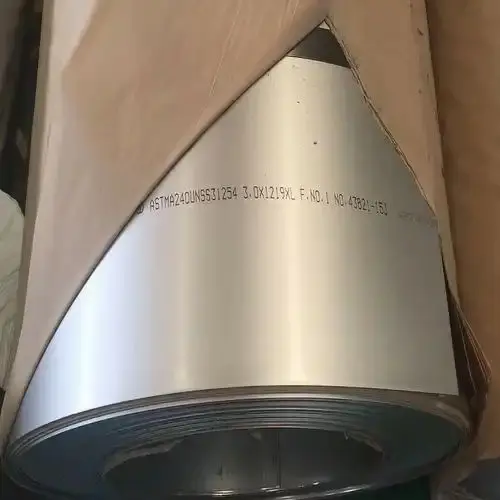The Uses of ASTM A240 Stainless Steel

ASTM A240 is a special type of stainless steel companies use in environments where steel with higher corrosion resistance is a requirement. The types 316 and 316L ASTM A240 steel are chromium and chromium-nickel plates used in different marine applications. Understanding what ASTM A240 is and its many uses can help you decide if this is the right type of steel plate for you.
Understanding ASTM
What is ASTM A240 Stainless Steel?
Where is ASTM A240 Use for?
Does ASTM A240 Rust?
Will ASTM 240 Prevent Product Contamination?
What is the difference between 304 and 304L stainless steel?
FAQs
Understanding ASTM
ASTM International is an industry-standard used by businesses in developing products. More than 12,000 ASTM standards are produced yearly, and these are included in the Annual Book of ASTM Standards.
Also, more than 140 countries are members of ASTM International. These members create international and national standards or regulations for all kinds of products, including regulations to manufacture stainless steel.
BEST 304 Stainless Steel Products in China
You can get the more cost-effective 301 stainless steel material from Yaoyi. Thickness 0.1 mm~0.3 mm, width 550-600 mm cold rolled stainless steel coil.
What is ASTM A240 Stainless Steel?
ASTM A240 are types of steel plates that include Austenitic Steels, Martensitic Steels, and Ferritic Steels. These types come with different chromium and nickel contents and have varying properties like tensile strength, yield strength, hardness, elongation, etc. Also, ASTM A240 steel plates are great for various applications, especially in oxidizing and atmospheric environments.
ASTM A240 steel plates offer enhanced corrosion resistance even when welded. This type of steel may be further upgraded or treated using cold drawing or cold rolling. These treatments enhance the magnetic properties of annealed steel plates but may be corrected using other processing techniques.
Chemical Composition (ASTM A240)
ASTM A240 stainless steel plates, strips, and steel sheets manufacture all kinds of materials for demanding environments. The chemical composition of ASTM A240 varies depending on the grade of the steel plate.
The most prominent element in ASTM A240 plates is chromium which varies from 0.75 to 20%, manganese 0.45 to 2%, silicon from 0.15 to 1%, molybdenum from 0.15 to 3%, carbon from 0.08 to 0.36%, phosphorus from 0.035 to 0.04%, sulfur from 0.030 to 0.040 and traces of aluminum and vanadium.
AISI 304 2B: One Of The Most Commonly Used Stainless Steel
Grades of ASTM A240
ASTM A240 stainless steel is classified into different grades. Each of these types has varying raw material or elements used and therefore varies in properties and features.
Grade 304
This type of ASTM A240 steel is 18-8 chromium-nickel austenitic stainless steel. Many industrial companies and manufacturers of kitchen equipment mostly use this grade. This grade has a high heat resistance and corrosion resistance.
Grade 304L
Grade 304 stainless steel has a maximum carbon content of 0.08%, while 304L has 0.03%. The letter L in 304L means extra-low carbon content makes this type of steel effective in severely corrosive environments.
Grade 316
Grade 316 stainless steel is the standard molybdenum-rich steel, one of the most widely used austenitic steel. Because of its high molybdenum amounts, 316 is highly corrosion-resistant, especially crevice corrosion and pitting in environments with high chloride content.
Grade 321
Grade 321 is stabilized stainless steel, commonly used in environments with extremely high continuous or intermittent temperatures. This kind of steel is used within the chromium carbide precipitation range of 800 to 1500 degrees Fahrenheit or 427 to 816 degrees Celsius.
Grade 410
Grade 410 is mostly used in fastening materials as this offers high corrosion resistance and strength. This type of steel is general-purpose steel and is effective in environments with steam, chemicals, and mild atmospheres.
Grade 904L
Grade 904L contains high amounts of chromium and nickel as well as molybdenum and copper. This excellent mix creates a corrosion-resistant material for highly corrosive environments.
Grade S31803
Another corrosion and stress-resistant steel is S31803 grade steel. It is useful in warm seawater environments and many other applications.
Grade S32205
Another name for S32205 is Duplex 2205. This grade is nitrogen-rich stainless steel making it strong and highly resistant to corrosion. This grade of steel is effective in acidic conditions.
Grade S32760
S32760 is also known as F55. It is a super duplex, high-alloy stainless steel that’s sturdy and resistant to corrosion. Above all, this type of steel is used in the manufacture of chemicals and petrochemicals.
Grade 31254
Grade 31254 is classified as super austenitic stainless steel that has high molybdenum and nitrogen content. This grade is stronger compared to common austenitic stainless steel and is resistant to crevice corrosion and pitting.
N08020
This grade is often used in many applications such as pressure relief valves, control valves, and centrifugal pumps. It combines different elements, including chromium, carbon, copper, manganese, nickel, molybdenum, iron, phosphorus, sulfur, and silicon.
AISI 301 Stainless Steel Properties
Where is ASTM A240 Use for?
These stainless steel plates, specifically chromium, chromium-manganese-nickel, and chromium-nickel plates, sheets, and strips, have many uses. Aside from general stainless steel applications for buildings, architectural, aesthetic, and construction uses, pressure vessels, and other demanding environments utilize ASTM A420.
Transport and Architecture Purposes
ASTM 420, specifically grades 304 and 304L, are standard materials for manufacturing different materials and equipment. These grades are essential in the fabrication of stainless steel components as well.
Grade 304 stainless steel plates form components needed in many sectors, including architectural and transportation industries. From stainless steel coil plates to plate mills, different industries use plates in varying widths from 36 inches to 2 meters. Coils are available from 96 to 240 inches long. Meanwhile, companies may also order plates and coils in customized sizes.
Commercial Kitchen Appliances
Aside from its extensive use in the transportation and architectural industry, ASTM A240 304 and 304L stainless steel are also common in manufacturing home and commercial equipment. It is the material of choice for commercial sinks, benches, oven tops, troughs, and cooking equipment.
Stainless steel is also common in making commercial countertops, ovens, refrigerators, and many more. ASTM A420 stainless steel is the best material because it is easy to clean, odor and stain-resistant, and can take extreme temperatures.
Food Processing Industry
ASTM A420 is non-corrosive and will resist all kinds of chemicals, making it the ideal building material in manufacturing food processing machines. Compared to other materials, stainless steel is easier to clean and maintain, making it great to manufacture all kinds of food products.
Finally, ASTM A420 has high heat resistance with 304 and 304L reaching 800 to 1580 degrees Fahrenheit. This way makes these stainless steel plates good for cooking and baking.
AISI 301 Properties: Characteristics, Compounds, and Applications
Does ASTM A240 Rust?
ASTM A240 is resistant to rust because of how it’s made. In addition, it contains chromium, iron, silicon, carbon, manganese, nickel, and molybdenum, which react with oxygen coming from water and air. These form a thin yet durable surface that can resist corrosion. Chromium is also necessary for forming this corrosion-resistant film. Almost all stainless steel products compose of at least 10% chromium.
The film also creates a shield that stops oxygen and water from accessing the material underneath. This protective layer is also tight and can protect the material from corrosion even at atomic levels.
AISI 301 Equivalent: Components, Processing, and Applications
Will ASTM 240 Prevent Product Contamination?
ASTM A240’s corrosion resistance, formability, strength, and ability to withstand extreme temperatures. Therefore, making it an ideal material in food, chemical, pharmaceutical, petrochemical, and other industries. Austenitic stainless steels are low-maintenance materials and are easy to clean and sterilize. Hence, product contamination is less likely to happen with ASTM A240 equipment.
AISI 301 Chemical Composition: Characteristics, Compounds,and Grades
What is the difference between 304 and 304L stainless steel?
304 stainless steel has 2.0% manganese, 0.75% silicon, 0.045% phosphorus, 0.03% sulfur, 18 to 20% chromium, 8 to 10.5% nickel, 0.10% nitrogen and 0.08% carbon. 304L stainless steel has similar components except for carbon which is only 0.03%. The L in 304L stands for lower or less carbon content. 304L also has a higher nickel content at 12% compared to 304, with only 10.5%
ASTM A240 Material: Applications and Classifications
Which is better, stainless steel 304 or 316?
304 and 316 have different components and properties, so it’s impossible to see which one’s better. 304 has a high melting point, so it’s best for standard stainless steel applications. Meanwhile, 316 is best at resisting chemicals and chlorides.
Always Provides You with the BEST Austenitic Stainless Steel Products
Which ASTM A240 grade is the best?
According to experts, stainless steel grade 304 is the most superior for its usage in many applications because of its ability to resist corrosion. It can withstand oxidizing acids, easy to clean and sanitize, and will never smell or discolor.
Can you polish ASTM A240 steel?
You can polish ASTM A240 304 and 316 stainless steel plates in any finish.
Can you heat treat stainless steel?
Applying heat to ASTM A240 stainless steel won’t result in a more durable or stronger material. You can’t heat treat stainless steel.
ASTM A240 stainless steel plates are the backbone of most processing and metal fabrication industries. Additionally, this material excels in many properties. Therefore, making it the best choice for applications like welding, forming, machining, laser cutting, and more. Get to know ASTM A240 better and determine if this is the right material you need for your business.
A Manufacturer of Stainless Steel Strips
Reference
https://www.astm.org/ABOUT/factsheet.html
https://www.imoa.info/download_files/stainless-steel/Specification-and-guideline-list.pdf
https://boltport.com/specifications/astm-a240-grades/
https://www.scientificamerican.com/article/why-doesnt-stainless-steel/
https://www.sciencedirect.com/topics/materials-science/austenitic-stainless-steel
https://www.pennstainless.com/stainless-steel-plate-304-304l-astm-a240/
